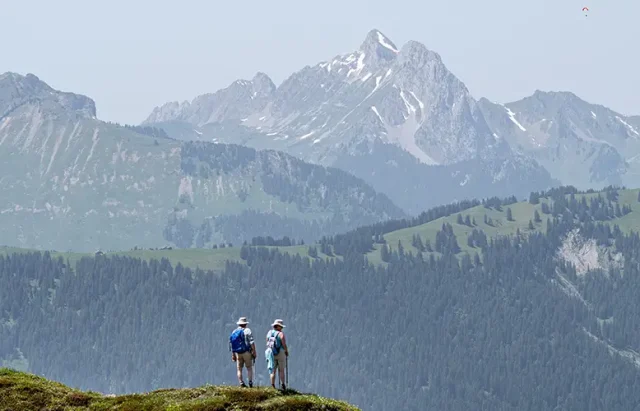
There are places in Europe that feel like they were designed for walking — where trails wind effortlessly from valley to summit, where each footstep leads deeper into history, and where the landscape feels alive in every direction. Austria is one of those places. For centuries, locals have moved through the highlands on foot: to pasture sheep, reach isolated huts, follow pilgrimage routes, or simply get from one village to the next. Today, those same paths have become part of a world-class network of hiking trails that offer a perfect mix of alpine beauty, cultural depth, and restorative solitude.
Hiking in Austria is less about conquering nature and more about coexisting with it. The trails are carefully maintained, the signage intuitive, and the journey is enriched by age-old traditions that remain very much alive in the huts, farms, and small towns scattered across the terrain. From dramatic high-altitude routes to gentle lakeside walks, Austria invites you to slow down, breathe deeply, and rediscover a quieter kind of travel — the kind that lingers.
A Landscape Designed to Be Walked
Austria is a country shaped by mountains. Roughly two-thirds of its territory lies in the Alps, but what surprises many first-time visitors is how walkable those mountains actually are. The Austrians have long believed that nature should be accessible — not dominated — and it shows in their trail system. With over 50,000 kilometers of marked hiking paths, Austria offers a level of outdoor access that few countries can match.
Trails often begin right at the edge of town, winding through meadows of wildflowers, shadowy pine forests, or up into the high Karst plateaus and glacier-fed valleys. Along the way, it’s not unusual to pass centuries-old chapels, hillside farms, or shepherd huts where you might be offered a slice of alpine cheese or a cool glass of buttermilk. These are not curated tourist moments. They’re part of a living landscape — and one that hikers are warmly welcomed into.
From Day Walks to Hüttentouren
Not all Austria hiking tours involve backpacks and blistered heels. Some of the most rewarding experiences can be found on half-day or full-day walks that return to the comfort of a village base. Regions like the Salzkammergut — with its glacial lakes and storybook towns — or the meadows and panoramic ridgelines around Seefeld and Alpbach are perfect for those looking for scenic walks with soft beds and hearty meals waiting at day’s end.
But for those seeking deeper immersion, hut-to-hut hiking (known locally as Hüttentouren) is the way to go. These multi-day treks wind through Austria’s high mountain terrain, linking a chain of alpine huts that provide simple meals, dormitory-style beds, and a place to swap stories with fellow travelers. The trails themselves vary in difficulty — some are gentle balcony paths hugging the contours of the mountains, while others demand real stamina and surefootedness. Either way, the reward is the rhythm that emerges after a few days on the trail: wake, walk, eat, rest, repeat — punctuated by vast skies and mountain silence.
The Eagle Walk in Tyrol, the Rätikon Höhenweg near the Swiss border, and the Schladminger Tauern traverse are just a few of the renowned multi-day routes that offer that magical balance of challenge and simplicity. And because the infrastructure is so solid, these journeys can often be done without guides, using GPS tracks, maps, and pre-booked hut stays — an ideal blend of adventure and self-direction.
Culture, Food, and Alpine Ritual
What makes hiking in Austria feel distinct is not just the scenery, but the sense of place. The alpine world here is not an untouched wilderness — it is shaped and lived in. Many trails follow old trade routes or shepherd paths. Wooden signposts with yellow arrows still bear the names of mountain passes known for centuries. In every valley, dialects and culinary traditions shift subtly, and hikers are never far from a warm welcome and a plate of something regional.
The food, in fact, becomes part of the experience. Mountain huts and trailside inns serve a version of Austrian cuisine that is earthy, satisfying, and deeply rooted in its environment. A bowl of Kaspressknödel soup (cheese dumplings in broth) on a breezy terrace, or a slice of apple strudel after a long descent, tastes like more than a meal — it tastes like you’ve earned it.
Even the gear culture reflects a certain ethic. Austrians hike with care and intention. It’s common to see older couples with trekking poles and weathered boots who’ve been doing this for decades. There’s an unspoken code: say hello on the trail, yield to uphill walkers, respect the silence in high places. It’s not rigid — it’s respectful.
Where to Go: Choosing Your Region
Austria’s hiking regions are many, but each offers something unique. Tyrol, perhaps the most iconic, is all about big alpine drama — jagged peaks, deep valleys, and high trails that look down across miles of wilderness. Vorarlberg, in the west, is more subtle and less trafficked — a dream for those wanting peace, architectural beauty, and lush forested hills. Salzkammergut, east of Salzburg, is a lake district straight out of a fairy tale, with gentle terrain and trail networks that lead between heritage towns and mountain viewpoints.
Further south, Carinthia offers sunny skies and border-spanning routes, including sections of the Alpe-Adria Trail, which begins in Austria and crosses into Slovenia and Italy. That trail — a masterpiece of slow travel — links three cultures and showcases the gentle transition from alpine to Mediterranean climates. For hikers wanting to blend natural beauty with deeper regional immersion, it’s hard to beat.
When to Go and What to Expect
The hiking season in Austria runs roughly from late May through early October, though snow levels at higher elevations can extend or shorten that window. July and August are the most popular — and most reliable — months for hut-to-hut tours, while June and September offer quieter trails and milder weather.
Weather in the mountains can shift quickly. Morning sun can give way to afternoon thunder. Hikers should always carry layers, waterproof gear, and be prepared to turn back when storms roll in. But even on rainy days, there’s something beautiful in the mists curling through valleys, the clink of cowbells echoing through fog, the comfort of soup in a warm hut.
Walking into Presence
There’s something different about discovering Austria on foot. It’s not just the views — though they are spectacular. It’s not just the food, the huts, or even the pristine nature. It’s the feeling of being in motion, of moving through a landscape with your whole self, not separated by glass or timetables. You begin to move at the pace of your own thoughts. You start to notice things again — the weight of your pack, the arc of a crow’s flight, the way the clouds gather behind a distant peak.
In a world that pushes us to scroll faster, drive farther, and do more, Austria’s hiking trails offer something radical: the chance to simply walk, to follow old paths through new terrain, and to return — not just with photographs, but with clarity.





